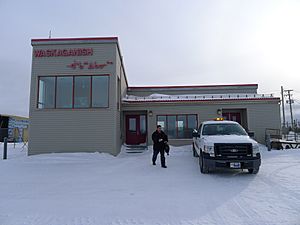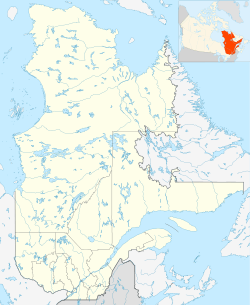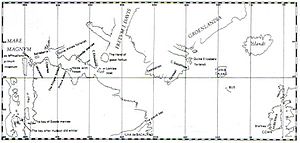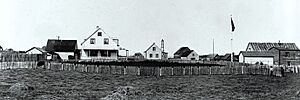Waskaganish facts for kids
Quick facts for kids
Waskaganish
ᐙᔅᑳᐦᐄᑲᓂᔥ (Cree)
|
|
|---|---|
|
Cree community
|
|

|
|
| Etymology: Little House | |
| Country | Canada |
| Province | Quebec |
| Region | Northern Quebec |
| TE | Eeyou Istchee |
| Formed | 1978 |
| Government | |
| • Type | Cree reserved land |
| Area | |
| • Land | 496.99 km2 (191.89 sq mi) |
| Population
(2021)
|
|
| • Total | 2,536 |
| • Density | 5.1/km2 (13/sq mi) |
| Time zone | UTC−05:00 (EST) |
| • Summer (DST) | UTC−04:00 (EDT) |
| Postal Code |
J0M 1R0
|
| Area code(s) | 819 |
Waskaganish is a vibrant Cree community located in Northern Quebec, Canada. It sits right where the Rupert River meets James Bay. The name Waskaganish means "Little House" in the Cree language. This area is part of a larger territory called "Eeyou Istchee," which means "The Land of the People" in Cree. It includes the traditional lands of the Cree people in the James Bay region.
Waskaganish is home to over 2,500 people. In 2018, the community celebrated its 350th anniversary! This village is built on the site of what was once Fort Rupert. This fort was the very first trading post of the Hudson's Bay Company on Hudson Bay.
Contents
A Journey Through Time
Ancient History: Before Europeans Arrived
People have lived in the James Bay area for a very long time, possibly as far back as 7,000 years ago. The oldest tools found near Waskaganish are about 3,000 to 3,500 years old. These early Aboriginal groups were hunters who moved from the south and west. At first, they came for seasonal hunting trips, but later they settled permanently in Eeyou Istchee.
Life for these early Cree people was based on hunting, trapping, and fishing. They also gathered plants and berries. Cree families, usually three or four, would move between their traditional hunting and fishing camps. They often stayed close to rivers and lakes.
In 2012, someone in Waskaganish found old stone blades and arrowheads. These tools, found near Saunders Goose Pond, could be between 4,000 and 7,000 years old! This shows just how long people have lived and thrived in this area.
Before Europeans arrived, the Cree traded with other Indigenous groups. They often traded moose hides for things like corn and tobacco. There was even an old trade route from Waskaganish to the Saint Lawrence River.
European Contact and Trading Posts
Some historians believe that Henry Hudson, an explorer, might have spent the winter of 1610-1611 in Waskaganish territory. His ship, the Discovery, got stuck in the ice in James Bay, forcing his crew to stay on land.
A ship called the Nonsuch arrived at the mouth of the Rupert River on September 29, 1668. It was led by Zachariah Gillam and guided by Médard des Groseilliers. This is when Rupert House, also known as Charles Fort, was built at Waskaganish. It was the very first trading post, built two years before the Hudson's Bay Company was even officially formed!
In October 1669, the Nonsuch returned to England. It carried a lot of beaver furs that they had traded with the Cree people. In exchange, the Cree received items like knives, kettles, beads, and blankets. The trading post was used on and off, and more buildings were added over time.
By the 1680s, the Hudson's Bay Company had many trading posts in the Cree traditional lands around James Bay. The Cree people became important partners in this trade. They acted as middlemen, collecting furs from other First Nations further inland. The Cree also became "homeguard" for the Hudson's Bay Company. This meant they helped supply and maintain the trading posts during the winter.
Over the next century, the fort was sometimes captured by the French and then taken back by the English. In 1776, the site was settled again and named Rupert House or Fort Rupert. For many years, Fort Rupert was a very important place for trade. It supplied communities and other posts further inland using canoe brigades on the Rupert River.
Modern Times: Big Changes and Agreements
The James Bay Project and Its Impact
Life for the Cree people of Waskaganish and Eeyou Istchee changed a lot because of the James Bay Project. This huge project involved building large hydroelectric dams. Even though many people called it "The Project of the Century," the Cree people had not agreed to it. In fact, they weren't even asked about it until construction had already started!
A big problem was about land rights. The land around James Bay had been the traditional home of the Cree and Inuit for thousands of years. Unlike other parts of Canada where agreements (treaties) had been made about land, no such agreements existed in Eeyou Istchee. This meant that the groups building the project, Hydro Quebec and the Government of Quebec, didn't have a clear legal right to build on this land.
To deal with this, the Cree people formed the Grand Council of the Crees. They chose Billy Diamond to be their Grand Chief. He represented the people of Eeyou Istchee in talks with the Quebec Government. The Cree were worried about serious damage to the environment. They also feared that their traditional hunting and fishing areas would be destroyed. This would greatly affect their traditional way of life.
A Historic Agreement for the Future
The Cree people and the Grand Council couldn't stop the dam from being built. However, through long talks, they created a very important agreement called the James Bay Northern Quebec Agreement (JBNQA). This agreement included rules about how the land could be used, how the economy would develop, and how Indigenous peoples could govern themselves. It also provided money for cultural, social, and health services for the Cree people.
Even though it took some time for parts of the agreement to be put into action, the funding from the JBNQA led to big improvements in Cree communities. For example, new water and sewer systems were built. The agreement also led to the creation of the Cree Board of Health and Social Services of James Bay (CBHSSJB) and the Cree School Board (CSB). These organizations help provide important services to the Cree people.
Getting Around: Road Access
For a long time, you could only reach Waskaganish by airplane or boat. But in 2001, a gravel road was built. This road connected the community to the James Bay Road, making it much easier for people to travel to and from Waskaganish.
Famous Faces from Waskaganish
- Billy Diamond was a very important leader. He was the chief of the Waskaganish Cree starting in 1970. He also became the Grand Chief of the Grand Council of the Crees of Eeyou Istchee.
- Filmmaker Neil Diamond grew up in Waskaganish. When he was a child, he watched Western movies in the church basement with other kids. This experience later inspired him to make his famous film, Reel Injun.
Learning and Education
The Cree School Board runs two schools in Waskaganish:
- Annie Whiskeychan Memorial Elementary School (for younger students)
- Wiinibekuu School (for older students)




